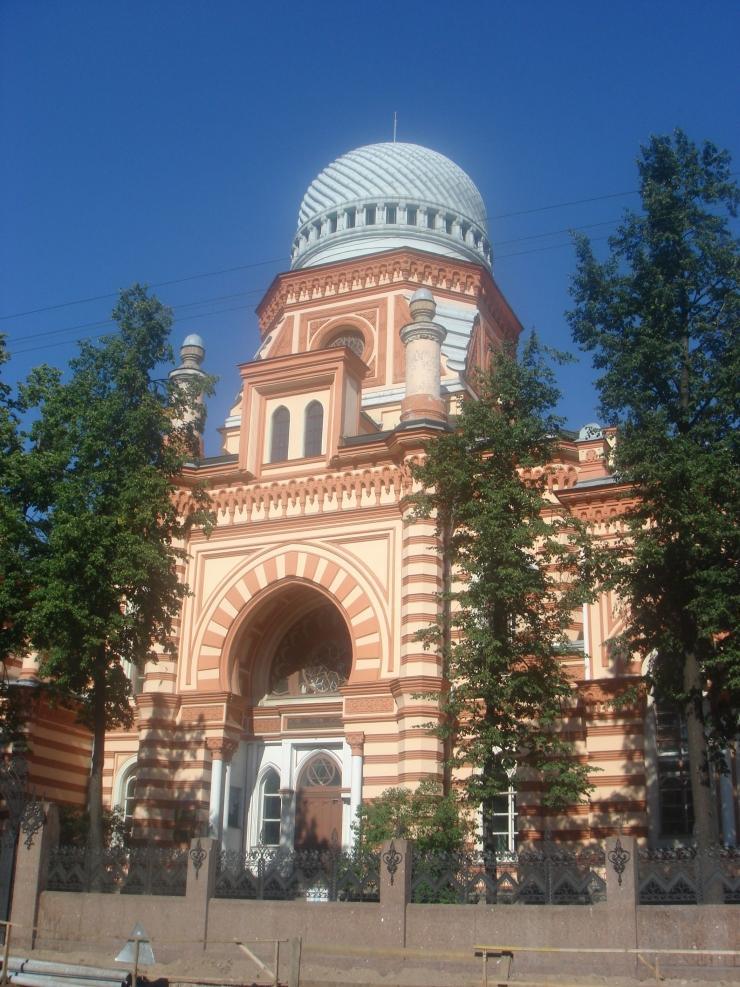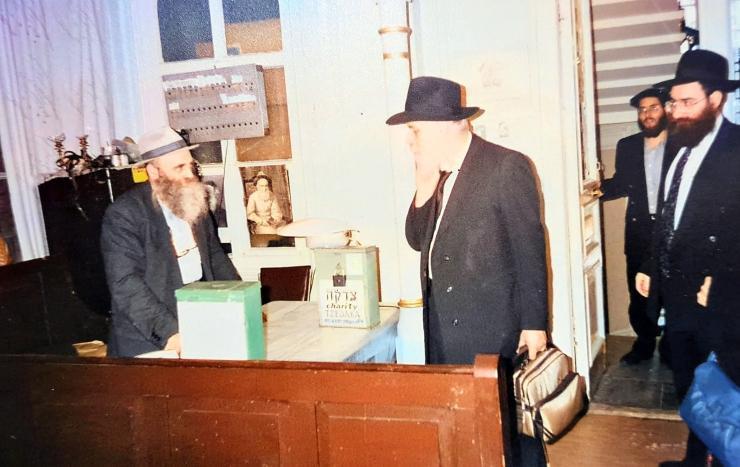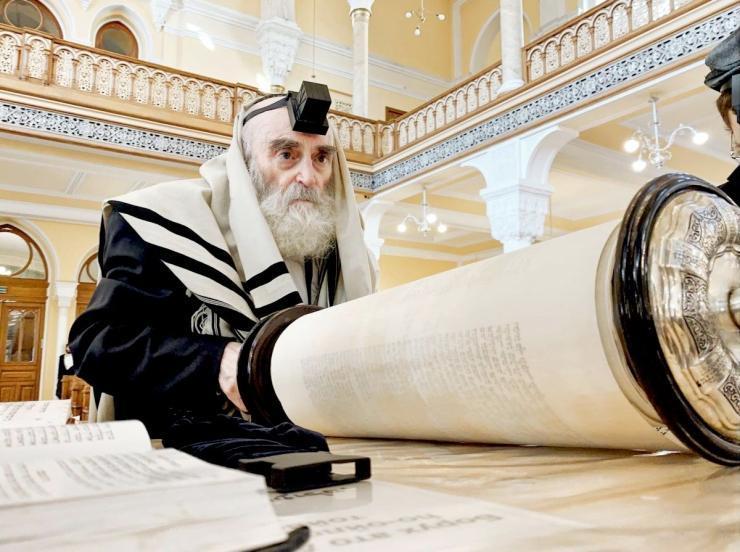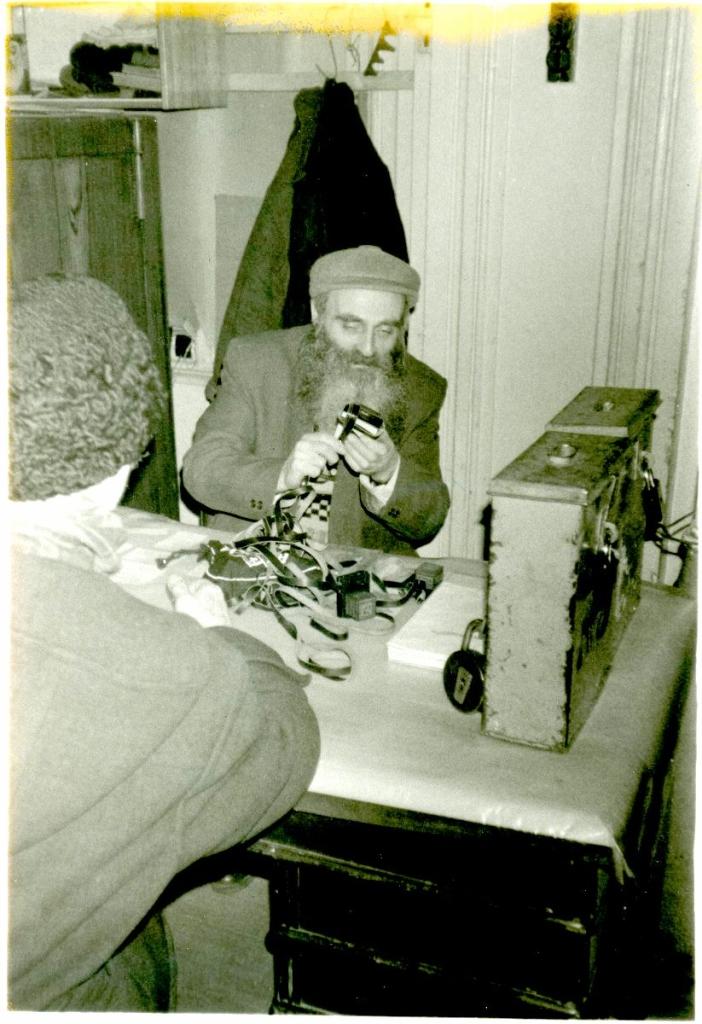After 90 Years in Leningrad, The Shamash Went To Shed On High Light
He was no “lamdan,” no “maskil,” and not even what we would ordinarily call an “oveid.” He was just a simple Jew who knew nothing more than what his job is in this world and how to fulfill it best. Reb Zushe Gurewitz, a silent pillar of Leningrad’s Jewish community in the dark period, was instructed by the Rebbe to remain at his post as Shamash of the Chabad Shul in Russia’s former capital even when the gates opened wide and remain he did. This Shevii Shel Pesach he returned his pure soul to its Maker • A profile of a simple, not-so-simple Chassid • By Shneur Zalman Berger, Beis Moshiach Magazine • Full Article
By Shneur Zalman Berger, Beis Moshiach Magazine
The thousands of Jews who, over the years, walked into the Chabad shul adjacent to the Grand Choral Synagogue in Leningrad, later Petersburg, first encountered a Chassid with a long beard and kind eyes who sat next to a table near the entrance. From there, he ruled his “kingdom” quietly, modestly, and with unusual diligence.
This was R’ Zushe Gurewitz, the shamash, who was the life and spirit of the shul and oversaw its daily operations.
One usually writes about shluchim, rabbanim, illustrious Chassidim, and the like, and only rarely does one put the spotlight on a simple, modest Chassid who spent his entire life in the background, in order to show the world the greatness of simplicity, the humility, and the faithful soldier that he was.



The Grand Choral Synagogue in Petersburg that survived despite the German bombs
R’ Zushe did tremendous work in being mekarev thousands of Jews to Yiddishkeit and Chassidus.
R’ Zushe was born in Leningrad, raised there, and was one of the luminous Chassidic personalities of the city. He yearned to move to Eretz Yisrael like all his fellow Chassidim, but after being told by the Rebbe to remain at his post, he no longer considered it, not even in his old age, in order to spend the remainder of his days with his family who had moved there many years before. The Rebbe spoke and he, as a soldier, carried out orders.
“My grandparents, R’ Zushe’s parents, as well as his brother (my father) moved to Eretz Yisrael,” said his nephew, R’ Dovber Gurewitz of Nachalat Har Chabad. “After the fall of the Iron Curtain, my uncle wanted to join the family and move to Eretz Yisrael but he knew he had an important job as shamash and gabbai of the big shul and that he was mekarev many Jews, which is why he was unsure whether it was right for him to leave.
“In 5753, when I was in Beis Chayeinu, he asked me to ask the Rebbe whether he could join his family or had to stay. The Rebbe shook his head no and that was enough for him. With all the longing he had to go, he remained for another thirty years.
“It’s important to remember that my uncle wasn’t an outstanding personality; he wasn’t a maskil or an oveid, but a simple and upright Jew who didn’t know any chochmos. That was his greatness.”



The interior of the shul
DIFFICULT YEARS
R’ Zushe was born in 5693 to R’ Gershon Sholom and Malka Leah Gurewitz, Lubavitcher Chassidim. His parents had three sons. The oldest died in his youth. The second was Zushe, and the third was Binyamin who moved to Kiryat Gat and later to Rechovot, cities where he worked on the Rebbe’s shlichus with those who spoke Russian.
R’ Gershon Sholom had seen the Rebbe Rayatz and was one of those who accompanied him to the train station before he left Russia.
Despite the terrible years that Russian Jewry experienced, and the Chabad community in Leningrad in particular, in the Gurewitz home Jewish life continued with mesirus nefesh with the goal of preserving the ways of Torah and Chassidus. In those days, the communists ruthlessly persecuted Chabad Chassidim in Leningrad and threw many of them into prison or labor camps. Some were even murdered shortly after their arrest.
Despite the terror and danger, R’ Gershon Sholom accomplished a great deal on behalf of Yiddishkeit in Leningrad. Zushe and Binyamin were born after the Rebbe Rayatz left Russia but they remembered the large Chabad community and the many Chassidic personalities who were brutally hounded by the communists.
Zushe was eight-years-old when the Germans invaded Russia in World War II. The Germans laid siege to Leningrad and bombed it mercilessly. Hundreds of thousands of civilians died, whether by bombs, cold or starvation. Although the angel of death felled hundreds of thousands, the Gurewitz family survived and were miraculously saved by crossing a frozen lake during the winter. They escaped from the area of the bombing, far from the front. When the war ended, they returned to Leningrad.
“During the siege, an inexplicable belief became widespread among the citizens that where the Jews were was the safest from bombing,” R’ Zushe related later. “That’s why many people took shelter in the big shul, in the cellars of the shul and structures in the yard.
“Indeed, although the shul was a very tall building, miraculously, it was hardly damaged. The Germans saw the impressive building and could have bombed it, but for some reason, it remained intact. One time, a shell landed on the roof and went from there to the yard and did not explode. Another time, a bomb fell 200 meters from the shul and a bridge collapsed. Only one time did the shul sustain significant damage but it wasn’t destroyed. Not only did the shul remain intact but the property and furnishings remained intact.
“At the time, we lived near the shul, sixteen family members together with other Jews crowded into our apartment, mainly in the kitchen where the oven was in order to remain warm in the terrible cold of the winter.
“In those days, many died of starvation, cold and bombs and innumerable dead Jews were brought to the yard of the big shul until bodies filled the yard, the lobby and the cellar. In order to give them Jewish burial, special trucks were brought on which they loaded the bodies who were buried in mass graves. My father was part of the chevra kadisha [The ones who ran the mass burial of Jews were the Lubavitcher brothers-in-law, R’ Michoel Lipsker and R’ Boruch Shifrin – SZB].
“My father was in charge of writing down the names of the dead and in a thick notebook he wrote down each one’s name, where and when he was buried. Unfortunately, during the siege, the notebook was burned in one of the fires that broke out as a result of the bombing.



When Rabbi Binyamin Klein, the Rebbe’s secretary, visited Leningrad in the summer of 5756. From right to left: Rabbi Mendel Pewzner, Menachem Ziegelbaum, R’ Klein, R’ Zushe.
“During the war we escaped from Leningrad and afterward, we returned and my father joined the holy work of the chevra kadisha.
“After the arrest of Rabbi Avrohom Lubanov, rav of Leningrad, my father filled his place, doing shechita, brissos, etc.”
Rabbi Lubanov passed away at the end of the summer of 5733. Some time later, R’ Gershon Sholom wanted to move to Eretz Yisrael. He managed to send his question to the Rebbe and he received the Rebbe’s answer, yes. The extended Gurewitz family moved at the beginning of 5734, and only R’ Zushe remained behind.
MASHPIA OF THOUSANDS
When R’ Zushe reached draft age, he served as a naval electronic technician in the Red Army. Upon his release, he went to work in a factory in Leningrad.
He made an ironclad decision not to work on Shabbos, no matter what. He got out of working on Shabbos, each time with another excuse. One time, despite all his pleading, the manager did not agree to let him go. Shabbos was approaching and he was not allowed to leave the premises. He got the exit permit only when it was turning dark and he had to walk home which took five hours!
In 5750, shortly after perestroika, R’ Zushe joined the staff of employees at the Chabad shul which began to blossom again with new life. The Chabad shul was actually a hall that was attached to the big shul.
All those who went to the shul at that time met the shamash-gabbbai, the old Chassid, R’ Avrohom Abba Ezdrin, who was approaching 90, which is why R’ Zushe was appointed the assistant shamash. R’ Avrohom Abba would always say that he was not allowed to leave his post because there was nobody to take over. When R’ Zushe began working there, he said now he could leave in peace. A few months later, he moved to Eretz Yisrael and since then, R’ Zushe was shamash as well as the gabbai. His wife, Mrs. Mara, joined the kitchen staff of the Chabad yeshiva in Petersburg and faithfully served the talmidim of the yeshiva for twenty years.



Having an aliya to the Torah in the renovated Chabad shul in his final years.
R’ Zushe was so devoted to his work that he never took a break, even for a day. After ten years on the job, he made a visit to Eretz Yisrael to see his family, some of whom he hadn’t seen in many years. Then he returned to his job.
When Rabbi Mendel Pewzner went to Petersburg on shlichus, he saw the devoted work of the Chassid who had been born and raised in the city and knew it well. The shliach was assisted by him for many years in reaching the hearts and souls of more and more Jews.
“R’ Zushe was not only a shamash or gabbai but an unofficial mashpia,” said R’ Pevsner. “He was mashpia on many Jews who came to the shul to daven on a yahrtzeit or to say Yizkor for their dear ones. R’ Zushe knew how to grab them and keep in touch with them, to influence them in matters of Yiddishkeit.
“During the course of his work, he met numerous Jews who visited the shul. Many went to daven for a refuah, to make a ‘mi shebeirach,’ some wanted to ‘place an order’ for the saying of Kaddish for eleven months for their loved ones. Some went to get advice on Jewish matters. R’ Zushe, with his language of the heart knew how to find the way to the hearts of these Jews who weren’t seen in shul all year, and he kept in touch with many of them. He knew how to reach each one according to where he was at and succeeded in imparting to them messages and practical steps related to Torah and mitzvos.
“He forged a special connection with children who came to shul. He gave them candy and created a pleasant atmosphere for them in the shul.”



At the end of the davening, R’ Zushe wrapping tefillin of people who used them.
THE FILM: THE SHAMASH
His persona, despite his modesty and preference to remain in the background, captured the heart of a movie producer who made a documentary about him in Russian. It’s called “The Shamash.” It describes the work R’ Zushe did as well as his memories. In the film, he shares the heavy responsibility of his position.
In the beginning, we see R’ Zushe sitting at his table near the entrance and answering a phone call. From his brief responses one understands that he received another name of a departed person, one of the thousands that he received over the years, to pray for him. Accordingly, he explains to the person on the other end of the line how and when to light the yahrtzeit candle.
“I started this job on January 1, 1990 [4 Teves 5750]. In those days, there were only a few sefarim here. Among my tasks was fixing and binding torn sefarim. At the same time I dealt with delivering packages to sick Jews who couldn’t leave their houses. I would bring them money, matzos, medication, whatever they needed. I was the ‘hands and feet’ of the sick people who were housebound.”
In the documentary, R’ Zushe goes on to say that he is the gabbai and the shamash in charge of order and cleanliness, without viewing this as undignified. He is given names so he can say kaddish for eleven months and daven for them on their yahrtzeit. Every day, he lights special candles for the yahrtzeits of the departed listed in his notebook. Many also sent him names of sick people for him to pray on their behalf.
In the documentary, we see R’ Zushe between aliyos, making a “mi shebeirach” and reading a very long list of names of sick people, as more and more people crowd around him and add names for a refuah.
“I do all the jobs in this shul, organize, pray, explain. If I took it upon myself, then it’s all my responsibility. I am crazy about it,” he explains to the producer.
The documentary goes from one situation to another. Suddenly, you see R’ Zushe planning how to fix the automatic closing of the aron kodesh. Then you see him changing light bulbs or getting phone calls from people with questions about Judaism.
You can see him walking the streets of Petersburg while it’s still pitch black outside. He boards a bus in the early morning as he hurries to get to shul.
“I need to get up early and hurry; there is a lot of work at the shul. I need to organize and arrange everything. Soon, people will come and I need to give out tefillin that is right for each one and explain how to pray, etc.”
On his desk is a large, heavy pushka made of metal. He explains, “It’s a tradition of shamashim through the generations that they have a pushka. The money that is donated I give to Jews who need doctors and don’t have money to pay for this or for those who need help in various complicated situations, as well as help for Jewish burial for those who don’t have the means to pay for it.”



THE FINAL GOODBYE
In the past two years, his health deteriorated and he was unable to go to shul. He was at his post for thirty years until he passed away on Shevii Shel Pesach at the age of 90. He is survived by his wife and son as well as thousands of Jews who were influenced by him on countless occasions.
The community in Petersburg issued this sad statement:
“The Jewish community in Petersburg has been plunged into sorrow and tears. Today we part from R’ Zushe Gurewitz, the legendary shamash of the small shul. He died a few months before his ninetieth birthday and now, an era in our community has become history. R’ Zushe faithfully served the community for decades. There is not a single Jew who visited the small shul, even once, who won’t remember R’ Zushe. How much he helped, with deeds, advice, with the right word that literally touched the soul.
“He was sharp, generous and wise. He will remain forever in our hearts, in our memories.”
*
Beis Moshiach magazine can be obtained in stores around Crown Heights. To purchase a subscription, please go to: bmoshiach.org
112
Join ChabadInfo's News Roundup and alerts for the HOTTEST Chabad news and updates!









































